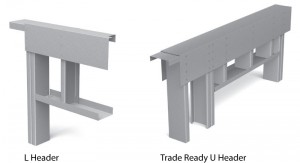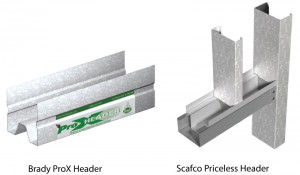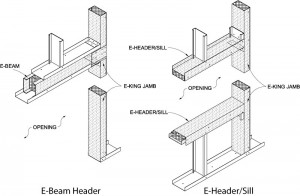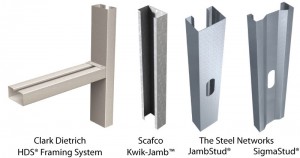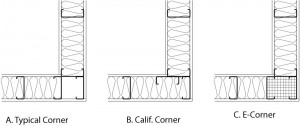As structural engineers, we typically don’t pay much attention to insulation issues. But modern energy codes are getting much stricter regarding the thermal integrity of the exterior building enclosure. You are likely seeing architects adding insulation in places that they didn’t worry about before, such as between slabs and foundation walls, and on the outside of the exterior sheathing on steel stud walls. These insulation planes can cause complications for structural engineers by placing a soft, non-structural element in the middle of our load path. The exterior insulation layer is one of those situations, especially where you need to support a heavy façade material such as brick or concrete. This insulation requirement is born out of the fact that steel studs are very thermally conductive and provide an easy path for heat to escape through the wall.
For all the concern about insulation, there is a common place where the lack of insulation gets overlooked – hollow boxed steel stud framing elements. Architects often don’t realize that boxed framing elements often do not get insulated. Boxed elements such as bundled studs, box headers and outside wall corners typically are inaccessible to the insulation contractor after they are built, and thus cannot easily be insulated. Even so, you have probably seen architectural details that show the batt insulation pattern continuing right through these boxed framing members. To insulate hollow framing elements, either the framing contractor must insert batt insulation, such as rock wool, as they assemble the framing, or foam insulation must be injected later by the insulator. Both of these methods are time consuming and costly, and don’t actually get done unless the specifications are very clearly written to force the contractor to provide insulation in hollow portions of the framing. Also, batt insulation material installed in the voids can get wet during construction and, once enclosed with sheathing, can take a long time to dry out. This has led to corrosion and mold problems in some projects.
Fortunately, cold formed framing (CFS) manufacturers are coming up with new products to allow engineers to avoid built-up hollow framing in many cases. These products fall into two categories; open shapes that are engineered to be stronger than standard CFS shapes, and pre-insulated framing members.
Several companies make open, insulatable headers. ClarkDietrich™ provides L-headers and U-shaped Tradeready® headers (Figure 1). They also, along with Cemco, are manufacturers of the Brady ProX header system. Scafco® provides the Priceless Header™. These are both custom break shapes that are open to accommodate insulation and also function as the track to attach the studs (Figure 2).
EnviroBeam has a preinsulated unit, the E-Header Sill™ that can be used for headers and sills, and consists of a pre-insulated hollow box shape that incorporates flanges to eliminate the need for an added track. For situations that still require a typical boxed header, EnviroBeam™ provides a pre-insulated version of box headers, the E-Beam™ (Figure 3).
As for jamb members at wall openings it is preferable, where loads permit, to use enlarged specialty stud shapes instead of bundled studs. (Figure 4). They not only allow the insertion of insulation but they are also much easier and less costly to install than built-up bundled studs. Such shapes are available from ClarkDietrich – HDS® Framing system, Scafco – Kwik-Jamb™ system, or the Steel Network – JambStud® and SigmaStud™ systems. EnviroBeam manufactures pre-insulated rectangular jamb stud shapes, the E-King™ system, also shown in Figure 3. Since the insulation is already provided, the E-King can be bundled to comprise even stronger members.
Outside wall corners are also problematic if one uses the traditional three-stud configuration of Figure 5a. After the sheathing is on, the corner is inaccessible for insulation. As is often done in wood framing, a preferable configuration is shown in Figure 5b, sometimes called the “California corner”. A pre-insulated corner member is available from EnviroBeam, called the E-Corner™ (Figure 5c).
While insulation isn’t part of our normal scope of work as structural engineers, we should be proactive wherever we can to provide the owner with a structure that does not compromise the energy efficiency that is ever more important these days. If hollow, un-insulated voids are built into the wall, the effective thermal opening sizes are significantly larger than typically used for heat loss calculations. On your CFS projects, consider using some of these or similar products. Avoid the use of box headers unless they are really necessary. In many cases they are not. At the very least, discuss the issue of missing insulation in hollow boxed elements with the architect. Make them aware of the issue and suggest that they include language in the specifications that clearly calls for insulating hollow voids in CFS framing.▪
More information can be found at these companies’ websites:
These products are presented here as options to consider; however, the author and STRUCTURE magazine do not endorse or promote them.

